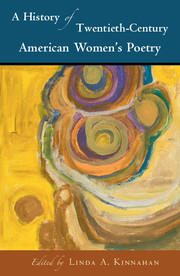Book contents
- Frontmatter
- Contents
- List of figures
- List of contributors
- Preface
- Acknowledgments
- PART I MAPPINGS AND CHRONOLOGIES
- PART II ETHNICITY, RACE, AND IDENTITY
- PART III MATERIAL FORMATIONS
- PART IV LINEAGES, TIES, AND CONNECTIONS
- PART V FORM, LANGUAGE, AND TEXT
- 19 Forgiving the Sonnet: Modernist Women's Love Poetry and the Problem of Sentimentality
- 20 The “do it yourself” Avant-Garde: American Women Poets and Experiment
- 21 Visual Poetics
- 22 Poetry and Technology
- PART VI CODA
- Bibliography
- Index
20 - The “do it yourself” Avant-Garde: American Women Poets and Experiment
from PART V - FORM, LANGUAGE, AND TEXT
Published online by Cambridge University Press: 05 June 2016
- Frontmatter
- Contents
- List of figures
- List of contributors
- Preface
- Acknowledgments
- PART I MAPPINGS AND CHRONOLOGIES
- PART II ETHNICITY, RACE, AND IDENTITY
- PART III MATERIAL FORMATIONS
- PART IV LINEAGES, TIES, AND CONNECTIONS
- PART V FORM, LANGUAGE, AND TEXT
- 19 Forgiving the Sonnet: Modernist Women's Love Poetry and the Problem of Sentimentality
- 20 The “do it yourself” Avant-Garde: American Women Poets and Experiment
- 21 Visual Poetics
- 22 Poetry and Technology
- PART VI CODA
- Bibliography
- Index
Summary
Introduction: American Democratic Experiment
The title of this essay comes from an essay by Eileen Myles, “How to write an avant-garde poem,” in which she argues, “avant-garde means do it yourself. … The American tradition of do it yourself, of permanently insecure and self-taught” (160). Myles's understanding of the avant-garde speaks to an American tradition, but it also speaks to a tradition of experimental women writers and artists who often found themselves outside or on the margins of avant-garde movements dominated by men, and who used this location as an impetus to innovation. In this essay I consider what a focus on twentieth-century women poets and experiment can teach us about the history and possibilities of an American “do it yourself” avant-garde. Instead of offering a chronology, this essay probes new ways of thinking about a history of women's poetic experiment.
Experiment: the word is endemic to the American nation itself, as a grand experiment in democracy. This democratic experiment, and its failures and contradictions, has been the subject of women's poetry from Anne Bradstreet and Phillis Wheatley onwards. However, democratic experiment takes on a modern, even modernist, connotation in the nineteenth century, when it is extended to the invention of new poetic forms. Three poets in particular – Walt Whitman, Emily Dickinson, Frances Harper – articulated distinct approaches to democratic experiment that would prove central to twentieth-century women poets. Whitman's democratic poetics – in which the organization of verse by linguistic structures other than meter signified the independence of American poetry from the English tradition and became a means of exploring, enacting, and measuring new political, social, and moral freedoms – provided a crucial template for women poets interested in writing free verse poems that involved readers by discovering and unfolding their own unique structures.
- Type
- Chapter
- Information
- A History of Twentieth-Century American Women's Poetry , pp. 323 - 338Publisher: Cambridge University PressPrint publication year: 2016
- 2
- Cited by

